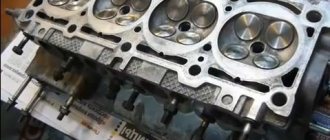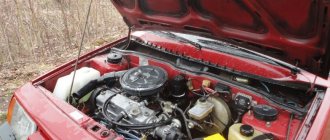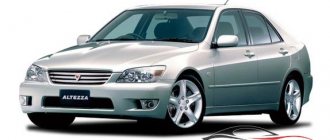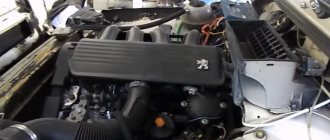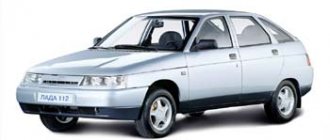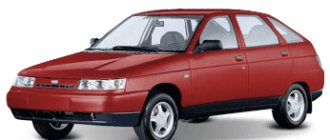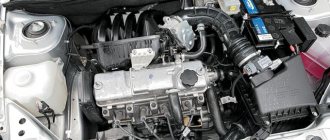Download .xls file
xls
Download picture
Send by email
| PARAMETER | MEANING |
| Number of cylinders | 4 |
| Volume, l | 1.596 |
| Piston stroke, mm | 75.6 |
| Compression ratio | 11 |
| Number of valves per cylinder | 4 |
| Cylinder block material | Ductile iron |
| Supply system | injector |
| Gas distribution system | DOHC |
| Cylinder operating order | 1-3-4-2 |
| Rated motor power | 78 kW (106.0 hp)/ 5800 rpm |
| Maximum torque | 148 Nm / 4000 rpm |
| Supply system | Electronically controlled distributed injection |
| Min octane number of gasoline used | 95 |
| Recommended Engine Oil | Synthetic |
| 5W-30 | |
| 5W-40 | |
| 10W-30 | |
| 10W-40 | |
| 15W-40 | |
| Oil volume in the lubrication system | 3.5 l |
| Oil quantity when changing | 3-3.2 l |
| Engine weight included, kg | 116 |
| Oil change carried out, km | 10000 |
The motor is installed on LADA Priora, Lada Kalina 2 and Lada Granta.
Description
The new VAZ 21127 engine is based on the VAZ-21126 gasoline engine, the main engine of the Priora, and is practically no different from it.
At the same time, the new Priora engine has some features:
- The engine is equipped with an intake control system, due to which it was possible to increase its power from 98 to 106 horsepower. With a 106 hp engine, according to owners' reviews, overtaking has become calmer.
- At the same time, the torque increased slightly to 148 Nm. The increase at average speed of the 127 engine was 10 Nm, which affected the dynamic characteristics of the engine.
- The engine control controller has received new calibrations, and instead of a mass air flow sensor, a DBP (absolute pressure sensor) is used. As a result of the modification, the VAZ 21127 engine received more improved parts.
Specifications
| Manufacturer | Concern "AvtoVAZ" |
| Start year of release | 2007 |
| Volume, cm³ | 1597 |
| Power, l. With | 98 |
| Torque, Nm | 145 |
| Compression ratio | 11 |
| Cylinder block | cast iron |
| Number of cylinders | 4 |
| Fuel injection order | 1-3-4-2 |
| cylinder head | aluminum |
| Cylinder diameter, mm | 82 |
| Piston stroke, mm | 75.6 |
| Number of valves per cylinder | 4 |
| Timing drive | belt |
| Turbocharging | No |
| Hydraulic compensators | There is |
| Valve timing regulator | No |
| Lubrication system capacity, l | 3.5 |
| Oil used | 5W-30, 10W-40 |
| Fuel supply system | injector, distributed injection |
| Fuel | gasoline AI-95 |
| Environmental standards | Euro 3 (4)* |
| Resource, thousand km | 200 |
| Location | transverse |
| Weight, kg | 115 |
| Tuning (potential) l. With | 400** |
*toxicity standards vary depending on the model of the installed collector (for Euro 4 model 11194-1203008-00(01)); ** without loss of resource up to 120 l. With
Design
- The four-stroke 127 engine of the Lada Priora has an in-line cylinder arrangement and a distributed injection system; The camshaft is located at the top of the engine.
- Closed cooling system with forced coolant circulation.
- A combined type lubrication system is supplied to the rubbing surfaces using pressure and oil spraying.
- The high-strength cast iron cylinder block is made by casting, and the walls are processed in accordance with Federal Mogul technology. Cylinder counting begins from the crankshaft drive pulley side.
Are the valves bending?
In Lada Priora cars, even in a 16-valve 126 power unit, valves can often bend. The reasons causing this defect lie in non-compliance with operating rules, in case of violation of the regulations for replacing the following components and parts:
- rollers;
- timing belt;
- water pump.
If one of the listed components breaks down, the pistons, exerting mechanical stress on the valves, can bend them. The design features of the engine are the reasons why the engine can bend valves. Deformation of the valves necessitates a major overhaul of the Priora engine.
Service
The power unit must undergo periodic maintenance every 10 thousand kilometers. Under severe operating conditions, oil and filter changes should be carried out every 7.5 thousand.
When replacing the oil filter, you should pay attention to oil leakage through the valve cover seals. This malfunction is due to the poor quality of the sealing gasket, which leads to contamination of the cooling surfaces and overheating of the motor.
A special feature of the maintenance of this engine is the periodic replacement of hydraulic valve compensators.
When operating a car with this engine, its temperature should be controlled - 95-98 degrees Celsius, otherwise the elements of the cooling system will wear out very quickly. The cause of this is usually the thermostat, which is the weak element in this system.
Removal of the exhaust pipe should be carried out with extreme caution; instead of copper nuts, the manufacturer installed steel ones; if they sour, the mounting brackets can break off. When carrying out this type of work, it is better to immediately replace these nuts with copper ones.
The worst feature of this engine is that when it fails, the engine bends the timing valve, leading to expensive repairs. Tensioning and replacing the timing belt is best done at a service center. The Lada Priora engine has 106 hp. p., according to reviews from owners, high-quality oil should be poured, otherwise the hydraulic valve compensators will fail very quickly.
The engine is also marked by knocking in the elements of the crank mechanism, main and connecting rod bearings, while the engine shakes.
Engine disassembly and repair
Repairs are carried out according to the standard procedure - we find faulty parts and replace them with working ones. The instructions below describe the process of disassembling the unit itself; before that, you need to dismantle it from the Lada Priora and thoroughly clean it of grease and dirt.
From the tools we will need regular and ring wrenches, a ratchet with an extension, screwdrivers, a pry bar and a stand. It is best to carry out repairs in a garage with good lighting.
Instructions
- Using the 13th key, remove the bracket fastenings. 4 nuts hold the front cylinder block support;
- We remove the bracket and move on to the left support - it is removed in exactly the same way;
Thus, you can completely disassemble the 16-valve engine and repair and replace faulty parts. But if the unit bends the valve, then only an experienced mechanic can handle the malfunction with his own hands. In any case, you will find out whether the motor bends the valves or not after removing the head cover.
- Engines
- VAZ
- 21126
The 1.6-liter 16-valve VAZ 21126 engine appeared in 2007 along with the Lada Priora and then spread to almost the entire model range of the Russian company AvtoVAZ. This unit was also often used as a blank for the concern’s sports engines.
The VAZ 16V line also includes: 11194, 21124, 21127, 21129, 21128 and 21179.
- Characteristics
- Description
- Consumption
- Application
- Reviews
- Service
- Breakdowns
- Prices
Malfunctions
Despite various upgrades, the engine in the VAZ 21127 retained all the faults of its predecessor, the main ones of which are shown in the table:
| FAULT | CAUSE |
| The engine starts to stall | Coking of injectors. |
| Malfunction of ignition coils. | |
| Reduced compression. | |
| Cooling system overheating | Thermostat malfunction. |
| Formation of a mud coat as a result of oil leakage. | |
| Knocks and noises at the top of the engine | Malfunctions of hydraulic valve compensators |
| Knocks at the bottom of the engine | Main bearing wear |
| Knocks in the middle of the engine | Connecting rod bearings and piston pin faults |
| Bend cylinder head valves | Belt drive slipping through gear tooth |
| Interruptions and startup problems | Violations in the operation of the timing belt. |
| Malfunctions in the fuel pressure system. | |
| Air leak. | |
| Broken throttle valve. | |
| Sensor malfunction. | |
| Power reduction | Burnt out timing head gasket. |
| Burnout of pistons, wear of rings and cylinders. |
Update
The new engine has a number of improvements that have significantly improved its performance. What's new in the series of engines that began production in 2007?
- Increased piston stroke. Thanks to this, the engine capacity was increased from 1.6 to 2.3 liters.
- New intake manifold, which improves performance at low and medium speeds.
- Automatic valve adjustment using hydraulic compensators.
- Upgrading the crankcase ventilation allows you to release less exhaust gases into the atmosphere. And reducing the weight of the piston group means the engine consumes less fuel.
- Most parts are imported.
- The motor has an extended service life of 200 thousand kilometers.
Tuning
Due to the fact that the design of the engine has not fundamentally changed, tuning the Priora engine is carried out using the same methods as on the 126 engine. In a Priora car, engine tuning can be done in several ways:
- The easiest way to do chip tuning of a Priora engine is to flash the control unit. Chip tuning will not make any significant changes to the technical characteristics of the engine; the increase will only be about 5 liters. With.
- To slightly increase the dynamic performance, it is enough to simply change the exhaust with a pipe diameter of 51 m and a 4-2-1 spider and change the damper with a size of 54 mm. These changes will increase engine power by 10-15 horsepower and slightly increase the dynamics of the car.
- For more serious tuning, you will need to install Stolnikov 8.9 shafts with a phase of 280. This change will increase acceleration to hundreds in 9 seconds.
- The use of 9.15 shafts with a 316 phase will make it possible to significantly increase the dynamics when starting in urban conditions, but for this you will have to bore the channels for the 31 mm/27 mm valve and change the injectors to more efficient ones. Injectors from BOSCH 431 360cc and BOSCH 440cc are well suited for these purposes.
The use of such changes will increase engine power by 30-40 horses. If these measures are insufficient, then the receiver will need to be replaced, a compressor installed, or the engine turbocharged.
How to extend the life of the motor?
Probably everyone understands that domestic cars belong to the economy class, therefore, when manufacturing them, they follow the path of making the design as cheap as possible. Such cars can withstand a quiet ride, but with aggressive driving they quickly break down. The Lada Priora, which is designed for very careful operation, also falls into this category.
Despite the fact that Priora engines have enough “horses” for dynamic driving, spinning the engine to high speeds is extremely undesirable. If you drive in a very quiet mode, then the engine can last 200-300 thousand kilometers. VAZ testers and engineers also name a much larger figure, 500 thousand kilometers of service life, although the plant provides only a 120 thousand-kilometer guarantee. But according to many car enthusiasts, this car can easily withstand half a million mileage if you drive it calmly. It is especially dangerous to overheat the engine and overload the car. Considering that the pump fails in Priora engines, you need to constantly monitor the coolant level and its temperature.
Another important point concerns the winter operation of the car. Like any other, the engine in a Priora does not tolerate cold starts. Currently, standard pre-heaters are being installed on the car; they come in the “Norma” configuration. But car owners often add heaters from other companies to Priora engines. If such a device is not installed, the engine must be thoroughly warmed up in the usual way before leaving.
When traveling long distances, it is recommended to drive without exceeding the speed limit. The optimal cruising speed for this car is 90-120 km/h. The larger the load, the lower the speed should be. You can also determine how heavy the engine is by looking at fuel consumption. If it increases greatly, it means that the mechanism is experiencing increased loads. In addition, it is worth remembering that the Priora’s engine power is sometimes not enough to drive on highways at high speeds. Therefore, with frequent overtaking, the engine inevitably becomes overloaded.
And the Lada Priora must undergo a high-quality run-in. The first few thousand kilometers you need to especially carefully monitor the speed, load and coolant temperature sensor. Driving slowly during the break-in period will increase the engine life.


